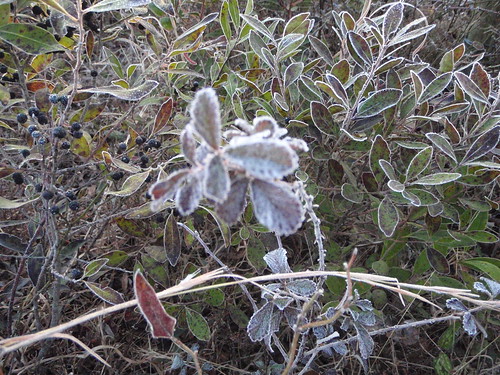Picture by Gretchen Quarterman, 8 Feb 2010, Lowndes County, Georgia.
Yearly Archives: 2010
What are these red things swimming in the pond water?
School Food: How to Change It
 The hardest part of what Jamie Oliver wants to
do to fix how we eat is to reform school food.
Fortunately, there’s somebody already doing it:
Ann Cooper already showed us how she does that three years ago:
The hardest part of what Jamie Oliver wants to
do to fix how we eat is to reform school food.
Fortunately, there’s somebody already doing it:
Ann Cooper already showed us how she does that three years ago:
Well, the CDC has gone further to say that those children born in the year 2000 could be the first generation in our country’s history to die at a younger age than their parents, and it’s because of what we feed them.And who teaches us to feed them that?
Big companies spent twenty billion dollars a year marketing non-nutrient foods to kids…. They spent 500 dollars marketing foods kids shouldn’t eat for every one dollar marketing healthy nutritious food.She feeds school children in Berkeley. You might think that would be easy, but when she started, it was just as bad as anywhere else:
…extremo burritos, corn dogs, pizza pockets, grilled cheese sandwiches, everything came in plastic, in cardboard, the only kitchen tools my staff had was a box cutter; the only working piece of equipment a can crusher.So she set out to fix it, and did. And if she can, we can.
Jamie Oliver on Food Education
 Jamie Oliver is a cook from England.
He’s trying to organize an intervention into the food system that’s killing us.
Jamie Oliver is a cook from England.
He’s trying to organize an intervention into the food system that’s killing us.
We spend our lives being paranoid about death, murder, homicide, you name it, it’s on the front page of every paper, CNN…. Look at homicide at the bottom, for God’s sake!The top three are heart disease, cancer, and stroke. Number 6 is diabetes. Those are the ones in red on Jamie Oliver’s graph. Homicide is number 15. See CDC for numbers. ( In 2006 72,449 people died of diabetes and 18,573 of homicide. You’re almost 4 times as likely to die of diabetes. And about 40 times more likely to die of heart disease.)Every single one of those ones in the red is a diet-related disease. Any doctor, any specialist, will tell you that.
I want to show a picture of my friend Brittney. She’s sixteen years old. She’s got six years to live. Because of the food that she’s eaten. She’s the third generation of Americans that hasn’t grown up within a food environment where they’ve been taught to cook at home or in school. Or her mum. Or her mum’s mum. She has six years to live!More pictures of people with very round faces and rounder bodies:
This is a normal family, guys!.We need to change normal. That’s what Jamie Oliver wants to do.
Obesity leads to diabetes and heart disease. And what leads to obesity? Lack of exercise combined with food stuffed with high fructose corn syrup (HFCS), salt, and fat in massive portions.
Fast food has taken over the whole country, we know that.Time to take it back.
I wish I could come up here today and hang up a cure for AIDS or cancer, you’d be fighting and scrambling to get to me. This, all this bad news, is preventable. That’s the good news. It’s very preventable.How? Vote with your food purchases. Demand a food ambassador in every supermarket. Demand big food businesses back food education. Get the government to work with the fast food purveyors to wean us off the fat, sugar, and salt. Schools, ages 4-whenever: proper fresh food cooked from local sources on site. Every child should leave school knowing how to cook ten recipes that will save their life. Corporate American should feed their staff properly. You can care and be commercial.
That’s his prescription. Doesn’t sound so hard, does it?
Bt Brinjal Beaten Back
 After nationwide protests against Bt Brinjal (eggplant),
BBC
reports that India does the right thing:
After nationwide protests against Bt Brinjal (eggplant),
BBC
reports that India does the right thing:
India has deferred the commercial cultivation of what would have been its first genetically modified (GM) vegetable crop due to safety concerns.I hope those opposed to Bt brinjal don’t think that’s the end of the story; it will be back. But at least for now they’ve won.Environment Minister Jairam Ramesh said more studies were needed to ensure genetically modified aubergines were safe for consumers and the environment.
Hm, I wonder if their approach would work for something else, such as bioengineered eucalyptus in the U.S. southeast? There are parallels: lack of serious studies of health effects and lack of demonstration of containment. Can Americans do what Indians just did?
Mutant Pigweed vs. Glysophate-Resistant Corn, Soybeans, and Cotton
 It’s a funny thing about monocultures. They’re highly vulnerable to anything
that affects that particular variety.
Dr. Mae-Wan Ho writes:
It’s a funny thing about monocultures. They’re highly vulnerable to anything
that affects that particular variety.
Dr. Mae-Wan Ho writes:
The scene is set at harvest time in Arkansas October 2009. Grim-faced farmers and scientists speak from fields infested with giant pigweed plants that can withstand as much glyphosate herbicide as you can afford to douse on them. One farmer spent US$0.5 million in three months trying to clear the monster weeds in vain; they stop combine harvesters and break hand tools. Already, an estimated one million acres of soybean and cotton crops in Arkansas have become infested.The palmer amaranth or palmer pigweed is the most dreaded weed. It can grow 7-8 feet tall, withstand withering heat and prolonged droughts, produce thousands of seeds and has a root system that drains nutrients away from crops. If left unchecked, it would take over a field in a year.
Meanwhile in North Carolina Perquimans County, farmer and extension worker Paul Smith has just found the offending weed in his field [3], and he too, will have to hire a migrant crew to remove the weed by hand.
Here’s the good news: Continue reading
Who Owns Monsanto?
 The answer in
1939
turns out to be about the same as in
2010:
minority shares by its own executives, and the majority by, well:
The answer in
1939
turns out to be about the same as in
2010:
minority shares by its own executives, and the majority by, well:
Last week’s survey of stockholders—lavish to the point of including pictures of “typical” Monsanto stockholders in the “typical” city of Cincinnati—was frankly designed to prove that Monsanto is not owned or run by any of “America’s 60 Families.”So, mostly funds in 1939. And 71 years later, it’s even more so. Continue readingOutstanding as of June 1, 1938, were 1,241,816 common shares held by 4,300 men, 4,084 women, 2,708 trusts, groups, institutions. Mr. Queeny holds only 3.4% has beneficial interest in about 4.5% more through relatives and trusts. One officer of the company owns 1.47%, no others own more than .25%.
The magazine named as “stockholders, once removed,” students in 42 universities which together own 1% of Monsanto and the 25,000,000 policyholders in 72 insurance companies which together own 3%. Tucked away in a graph was the fact that 81% of the company’s shares is owned in blocks of 101 or more shares ($102-to-$104 a share last week).
India Against Bt Eggplant
 Day before yesterday saw
Wide and vociferous protests against this genetically modified Bt brinjal:
Day before yesterday saw
Wide and vociferous protests against this genetically modified Bt brinjal:
From Gopal Ethiraj, ChennaiContinue reading
Chennai, 01 February (Asiantribune.com):Mr. Jairam Ramesh, Minister of State for Environment and Forests, on Sunday had to face angry protests of farmers in Hyderabad over a move to produce the genetically modified Bt brinjal in the country. Protests and demonstrations were also held in New Delhi, Bangalore, Chennai and Thiruvananthapuram on Saturday and Sunday.
He had gone there as part of public consultations on Bt brinjal. Consultations are being held in Kolkata, Bhubaneswar, Hyderabad, Bangalore, Nagpur, Ahmedabad and Chandigarh.
The Minister, however, said a final decision on the issue would be taken in 10 days after consultations with all concerned. The Genetic Engineering Approval Committee (GEAC) had last year given its nod for commercial release of Bt Brinjal and Ramesh had promised additional consultations with farmers’ groups, NGOs, scientists and other stakeholders before the release of Bt brinjal.
Demanding earlier that the government reverse its decision, farmers, scientists and NGOs staged angry demonstrations in Hyderabad and disrupted a public hearing organised by the ministry. The protestors did not allow the Minister to speak at the public consultation held at the Central Research Institute for Dryland Agriculture (CRIDA) in Hyderabad.
The Locavore Song
Every time I think about the things that I need.There’s more:
All I have to do is go and plant a seed.
Give it a little water and time to mature.
You can grow a miracle in cow manure.
I will get my food fresh from the vineGive it a listen:
For everything that grows is intertwined
And we will not lose hope
And we will cast our vote
at the checkout line.
Indian Cost of Pesticides and Fertilizers
By the late ’80s, the chemicals had started taking a toll. Mr. Govindan’s land dried up. Yields declined. Mr. Govindan said the quality of his crops did, too. In the old days, he told me, if you cooked too much rice for dinner you could keep it overnight and eat it the next day for breakfast. Now, rice from the fields around Molasur turned rotten overnight.How bad is it?Other things had changed: labor was more expensive, the price of fertilizers and seeds had increased, and the overall cost of living had outstripped the rise in crop prices.
The scientist M.S. Swaminathan, often referred to as the father of India’s green revolution, has spoken of a “disaster” in Indian agriculture. The sociologist Dipankar Gupta has written of “hollowed” villages.So is the Indian government being realistic about the problem?According to a recent report in The Hindu newspaper, almost 200,000 farmers committed suicide between 1997 and 2009 — a national tragedy (although it is rarely treated as such) brought on by rising debt and the resulting economic and existential despair.
Mr. Govindan wondered about something else, too. Farming had always seemed a special profession to him, with a vital, even noble, role in feeding the nation. He wondered why the country didn’t see it that way anymore. Just the previous night, he had watched Prime Minister Manmohan Singh on television, assuring the nation that it wouldn’t face food shortages. Mr. Govindan felt something didn’t add up. He pointed to the barren fields; he said you couldn’t even grow peanuts on them anymore. “I don’t understand,” he said, “Where is all the food supposed to come from?”Well, if India follows the U.S. model, the food will come from a tiny number of agrobusinesses that will end up owning most of the land.

